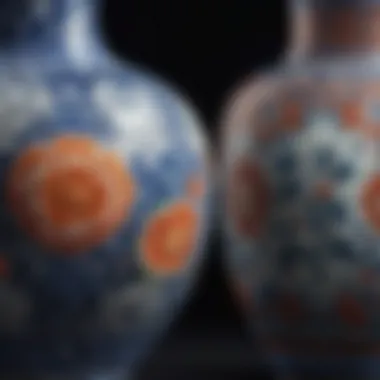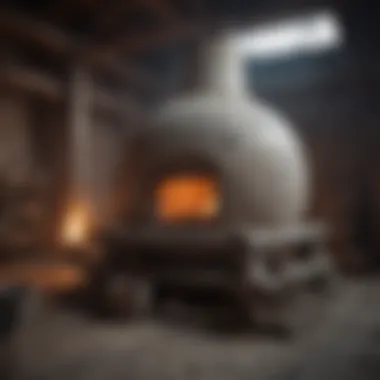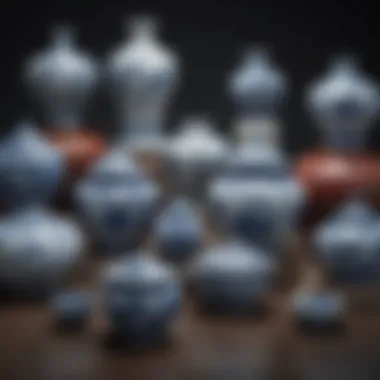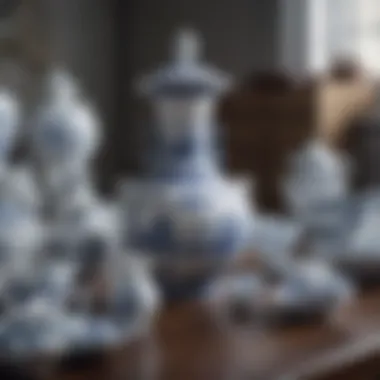Exploring the Depths of Chinese Porcelain Culture


Intro
Porcelain, a unique ceramic material known for its strength and translucence, has a profound history in China. The inception of porcelain began as early as the Han Dynasty, evolving through various dynasties to become a symbol of cultural identity and prestige. This article aims to explore the intricacies of Chinese porcelain, touching on its historical significance, manufacturing processes, and cultural relevance.
The journey of Chinese porcelain reflects the evolution of art and technology over centuries. From its ancient techniques to modern adaptations, porcelain's development is deeply intertwined with Chinese heritage. Today, it holds significant importance not only in China but also in international markets, influencing art, trade, and craftsmanship worldwide.
Understanding porcelain’s myriad aspects requires a systematic exploration of its key concepts, current research trends, and the ongoing dialogues surrounding its importance. This article intends to provide an insightful perspective for students, researchers, educators, and professionals interested in the topic.
The Historical Context of Porcelain in China
Understanding the historical context of porcelain in China is essential to grasp its evolution and significance. This context reveals how porcelain started as a form of pottery and transformed into a high-value art form. From its origins to modern-day adaptations, this section illustrates how cultural, social, and economic factors shaped the production and appreciation of porcelain.
Origins and Early Development
The development of porcelain in China began around the late Han Dynasty, approximately in the 2nd century CE. Early ceramics were primarily earthenware, but advances in material composition and firing techniques laid the groundwork for true porcelain. The creation of porcelain required kaolin, a fine white clay that remains essential in the process today.
Archaeological evidence suggests that the first porcelain pieces were rudimentary, serving utilitarian purposes. They lacked the fine aesthetic qualities seen in later varieties. Yet, this period was crucial as it marked the beginning of a complex relationship between technology and artistic expression in Chinese ceramic traditions.
The Tang and Song Dynasties
During the Tang Dynasty, which spanned from 618 to 907, significant innovations began to emerge. The period is often regarded as a golden age for Chinese ceramics. It was characterized by advancements in glazing techniques and forms. Pieces were often vibrantly colored and showcased the artisans' creativity. The relationship between porcelain and trade also flourished, as Tang merchants exported goods through the Silk Road, spreading the allure of Chinese ceramics beyond its borders.
The subsequent Song Dynasty, from 960 to 1279, refined these early advancements. A more subdued aesthetic became prominent, with an emphasis on simplicity and elegance. Celadon and white porcelain became symbols of high-quality craftsmanship. The Song artisans emphasized function and form, leading to the creation of exquisite teapots and tableware that captivated both local and foreign markets.
Porcelain in the Ming Dynasty
The Ming Dynasty, lasting from 1368 to 1644, saw porcelain reach new heights. Techniques such as blue and white decoration gained popularity during this time. The introduction of cobalt blue pigment allowed artisans to create distinct and intricate designs. The famous Ming vases, often characterized by their vibrant colors and elaborate patterns, became highly sought after in both local and overseas markets.
Ming porcelain was not simply about aesthetics. It also represented the consolidation of power and status among China's elite, as owning fine porcelain became synonymous with wealth and sophistication. The craftsmanship reached its zenith, and porcelain was also used in diplomatic gifts, further establishing its value in international relations.
The Qing Dynasty and its Innovations
The Qing Dynasty, which lasted from 1644 to 1912, continued the legacy of porcelain excellence with many innovations. The introduction of new colors, particularly the production of famille rose and famille verte, expanded the palette available to artists. This led to greater design variety and more personalized pieces.
During the Qing period, porcelain production became more commercialized, with the rise of factories capable of mass production. Despite this, the attention to detail and artistry remained high. The Qing era also saw porcelain adapted into various forms, including larger-scale decorative items that adorned palaces and tombs.
The Manufacturing Process of Chinese Porcelain
The manufacturing process of Chinese porcelain is a critical area to explore for a complete understanding of its significance in both historical and contemporary contexts. Various steps in its production not only affect the quality and aesthetic appeal of the porcelain but also illustrate the craftsmanship that has defined this art form over centuries. Understanding these processes sheds light on the intricate relationship between materials, methods, and the final product, showcasing why porcelain holds a venerable place within Chinese culture.
Raw Materials and Their Significance
The primary materials utilized in porcelain production are kaolin, feldspar, and quartz. Kaolin clay, characterized by its fine texture and white color, serves as the foundational material. Feldspar acts as a flux which lowers the melting point of the mixture, while quartz adds strength to the composition. The careful selection of these raw materials is paramount; even minor variations can lead to significant differences in the end product.
The sourcing of these materials often comes from specific regions. For instance, kaolin is predominantly found in Jiangxi Province. The geological properties of these sources contribute directly to the unique characteristics observed in different types of porcelain. Moreover, the significance of the raw materials extends beyond their physical attributes; they symbolize the deep connection between the land and the craft.
Kilns and Firing Techniques
Kilns play a crucial role in the porcelain-making process. The type of kiln used and its firing techniques directly influence the porcelain's durability, color, and surface finish. Traditional Chinese kilns, such as the dragon kiln, allow for large batch production with consistent firing results. These kilns can reach high temperatures, essential for transforming the raw materials into dense and vitrified porcelain.
Firing techniques can vary, with two primary methods: single-firing and double-firing. Single-firing saves time and energy but may lead to less control over the final product. On the other hand, double-firing, although more labor-intensive, allows for greater precision in achieving desired effects in both glaze and body characteristics.
"The kiln is not just a tool but a facilitator of transformation, turning mere clay into fine porcelain."


"The kiln is not just a tool but a facilitator of transformation, turning mere clay into fine porcelain."
Glazing and Surface Treatments
Glazing is a vital step in the manufacturing of porcelain. The application of glaze not only enhances the aesthetic appeal but also serves practical purposes, including protection against stains and moisture. The variety of glazes can result in different surfaces ranging from glossy to matte, and colors can span from deep hues to delicate pastels.
Different types of decoration may also be applied. Techniques such as underglaze painting, over-glaze decoration, and intaglio engraving are prominent in the artistic expression of porcelain. The choice of technique often reflects cultural traditions and personal styles, making this step not merely functional but deeply artistic.
Quality Control Measures
Quality control measures throughout the manufacturing process are crucial for maintaining standards. These include scrutiny of raw materials, monitoring firing temperatures, and assessing the final product for flaws or imperfections. Skilled artisans possess the ability to detect subtle issues that may not be visible to the untrained eye.
Quality assurance also encompasses the evaluation of aesthetic elements like glaze consistency and surface texture. Such measures ensure that the porcelain meets the expectations of both traditional standards and modern consumers.
In summary, the manufacturing process of Chinese porcelain is not just a sequence of steps but a rich tapestry of tradition, artistry, and technical skill. It reflects centuries of refinement and innovation, all contributing to porcelain's esteemed status within both Chinese heritage and the global market.
Cultural Significance of Porcelain
The cultural significance of porcelain extends beyond mere aesthetics; it serves as a tangible representation of Chinese heritage and traditions. Throughout history, porcelain has been intertwined with various aspects of Chinese society, encompassing social, ceremonial, and artistic dimensions. In this section, we will explore its role as a symbol of status, its incorporation into ceremonial practices, and its function as a medium of artistic expression.
Porcelain as a Symbol of Status
Porcelain has long been regarded as a marker of prestige and opulence in Chinese society. During the dynastic periods, particularly in the Ming and Qing dynasties, possessing porcelain was synonymous with wealth and social standing. The exquisite craftsmanship and intricate designs of porcelain wares made them highly sought after, both domestically and internationally.
"Porcelain's elegance is a canvas that reveals the socio-political dynamics of history"
"Porcelain's elegance is a canvas that reveals the socio-political dynamics of history"
In addition to being a luxury item, porcelain's rarity and the skill required for its production contributed to its valued status. The blue and white porcelain bowls, for instance, became emblematic of this appreciation, showcasing the beautiful cobalt designs against a white backdrop. Noble families often used these pieces during banquets, reinforcing their elevated social status.
- Ceramic Collectibles: Beyond functional ware, many pieces became collectibles, with various dynasties producing distinct styles. The collection of these items often indicated an individual's appreciation for heritage and culture.
- Gifts and Offerings: Porcelain served as prestigious gifts during diplomatic events, further solidifying its role in demonstrating status and power among elites.
Porcelain in Chinese Ceremonial Practices
The use of porcelain in Chinese ceremonial practices highlights its deep-rooted place in cultural rituals. Nearly all important life events, such as weddings, birthdays, and festivals, incorporate porcelain in various forms.
During wedding ceremonies, special porcelain teapots and cups are used to symbolize harmony and unity between families. Their delicate designs often reflect the themes of fertility and prosperity.
- Ancestral Worship: In ancestral worship, porcelain objects serve as offerings. They symbolize respect and reverence, demonstrating the connection between the living and their ancestors.
- Festive Rituals: For festivals like the Lunar New Year, family gatherings often involve the use of porcelain dinnerware, where meals are presented in ornate bowls that elevate the shared experience of communal eating.
Artistic Expression Through Porcelain
Porcelain is not only a functional item but also an art form deeply appreciated by collectors and artists. The artistic expression found in Chinese porcelain reflects a blend of technical skill and creative vision.
Artisans, through the ages, have utilized porcelain to portray landscapes, historical figures, and abstract designs. This form of expression contributes to the cultural narrative and is pivotal in preserving traditional themes.
- Artistic Techniques: Various glazing and painting techniques, like underglaze and overglaze methods, illustrate the diversity and depth in the artistry of porcelain production.
- Contemporary Art: In recent years, modern artists have embraced porcelain as a medium to challenge traditional boundaries, merging contemporary themes with ancient methods, thus fostering an ongoing dialogue about cultural identity.
The intricate journey of porcelain from a sign of prestige to a vessel of artistic representation showcases its profound impact on Chinese culture and beyond.
Global Influence of Chinese Porcelain
The influence of Chinese porcelain extends far beyond its geographical origin. This artistic and functional medium has shaped various cultural landscapes, especially in the West. Understanding this global influence is vital not only for the appreciation of porcelain itself but also for the insights it offers into cross-cultural exchanges and evolving artistic movements across history.


Prelude to Western Markets
The introduction of Chinese porcelain to Western markets occurred during the 16th century. Traders and explorers, drawn by its beauty and functionality, played a crucial role in this process. European merchant ships, especially those belonging to the Dutch East India Company, facilitated the transport of fine porcelain to Europe. Demand was high, with the pieces often viewed as luxury items. European nobles and merchants collected these wares, viewing them as status symbols.
As trade networks grew more robust, so did the availability of porcelain. Notable importation hubs, such as the ports of Amsterdam and Lisbon, became bustling centers for porcelain trade. The porcelain captivated the European aesthetic, leading to the adaptation of Chinese motifs into local styles. Consequently, the European fascination with porcelain motivated local potters to experiment with similar materials, seeking to replicate the prized Chinese creations.
Impact on European Ceramics
The global influence of Chinese porcelain is starkly observed in European ceramics, particularly during the Renaissance and Baroque periods. This period saw a marked transition where local artisans began to experiment with the techniques derived from their Chinese counterparts. The introduction of high-fired whiteware, influenced by the translucent beauty of Chinese porcelain, set the groundwork for European innovations in ceramics.
Several key movements emerged:
- Delftware: In the Netherlands, artisans created tin-glazed pottery that imitated Chinese styles, often incorporating blue and white designs reminiscent of Ming dynasty porcelain.
- Meissen Porcelain: In Germany, the discovery of hard-paste porcelain in the early 18th century marked a significant advancement. Johann Friedrich Böttger and his team developed a process to create porcelain that rivalled the quality of Chinese pieces, leading to a new era in European ceramics.
- Sèvres Porcelain: In France, the Sèvres factory became known for its luxurious porcelain, which was deeply inspired by the earlier Chinese works.
This cross-pollination of ideas fostered a dialogue between East and West, creating a unique blend of artistry and technique that defined European ceramic styles.
Porcelain in the Global Art Market
Today, Chinese porcelain holds a prominent place in the global art market. Its historical weight, combined with the craftsmanship involved, makes it highly sought after by collectors and institutions alike. Recent auctions have seen pieces fetch astronomical prices, underlining not just monetary value but also cultural significance.
Not only do collectors seek out ancient artifacts, but they also invest in contemporary works that draw on traditional techniques while pushing artistic boundaries. This modern reception has encouraged artists worldwide to reimagine what porcelain can be. Some artists blend materials, creating innovative works that challenge the conventional boundaries of porcelain art.
Furthermore, exhibitions dedicated to porcelain, both historical and contemporary, often draw large audiences. High-profile museums have established collections showcasing the continuum of porcelain art, affirming its relevance in contemporary discourse.
"Chinese porcelain is not simply an item of beauty; it embodies centuries of cultural exchange, innovation, and artistic evolution."
"Chinese porcelain is not simply an item of beauty; it embodies centuries of cultural exchange, innovation, and artistic evolution."
The global influence of Chinese porcelain, therefore, continues to resonate through various realms, from trade and artistry to cultural identity and value systems. This ongoing journey highlights porcelain's unique role as a link between cultures, fostering deeper understanding and appreciation of artistic heritage.
The Contemporary Landscape of Chinese Porcelain
The contemporary landscape of Chinese porcelain is a fascinating blend of tradition and innovation. It encompasses the ongoing evolution in production techniques, a resurgence of ancient methods, and its prominent role in modern art. This section is crucial because it highlights how historical practices adapt to meet present demands.
Modern Production Techniques
Modern production techniques of Chinese porcelain have largely adapted to technological advancements. Factories employ state-of-the-art machinery for shaping, glazing, and firing. The use of computer-aided design (CAD) allows for precise patterns and forms, enabling manufacturers to create intricate designs efficiently. This not only streams the process but also enhances the quality of the final product.
- Increased efficiency: Automated processes reduce time spent on repetitive tasks.
- Higher quality assurance: Advanced technology enables better quality control at every stage.
Despite these advancements, the essence of craftsmanship still remains. Craftsmen often oversee the production to ensure that the final products retain their traditional beauty. Thus, modern methods coexist with the age-old skills of artisans.
Revival of Traditional Methods
In recent years, there has been a notable revival of traditional porcelain-making methods. This is partly driven by consumer demand for authenticity and craftsmanship. Artisans are rediscovering ancient techniques that once defined Chinese porcelain.
The revival centers on techniques such as:
- Hand-painting: Each piece is meticulously painted by skilled artisans, leading to unique artworks.
- Kiln firing: Traditional wood and coal kilns are used, giving a distinctive texture and finish to the porcelain.
This revival is fundamental to preserving cultural heritage and providing a contrast to mass production. By embracing these methods, artisans not only honor their ancestors but also appeal to collectors and connoisseurs who value authenticity.
Porcelain in Contemporary Art


Porcelain has emerged as a powerful medium within contemporary art. Artists are experimenting with the material, pushing boundaries in design and concept. This evolution reflects a transition from mere functional objects to platforms for artistic expression.
Significant movements include:
- Installation art: Artists create large-scale installations that feature porcelain as a primary element, challenging perceptions of the medium.
- Sculptural works: Artists like Grayson Perry utilize porcelain to explore themes of identity and society.
Contemporary artists often collaborate with traditional porcelain makers to blend old and new techniques. The results yield thought-provoking works that resonate globally.
"Porcelain is not just a legacy; it is a canvas for dialogue between the past and present."
"Porcelain is not just a legacy; it is a canvas for dialogue between the past and present."
In summary, the contemporary landscape of Chinese porcelain is dynamic. It combines advancements in technology, a revival of traditional practices, and a significant presence in the art world. This multifaceted approach allows Chinese porcelain to retain relevance, ensuring its place both within China and on the global stage.
Preservation and Collecting of Porcelain
The preservation and collecting of porcelain is a critical topic in understanding its lasting significance. Collecting porcelain is not merely an act of acquiring beautiful objects; it serves as a pathway to educate future generations about cultural heritage and art history. This section explores fundamental aspects of preservation and outlines the role of collectors and museums in safeguarding this art form.
Porcelain has a rich and intricate history, and each piece tells a story of its origin, production, and use. Protecting these relics ensures that the artistry and craftsmanship are understood and appreciated in contemporary contexts. Collectors and institutions alike bear the responsibility of recognizing the value of these items, both materially and culturally.
Challenges in Preservation
Preservation of porcelain items is fraught with challenges. Environmental factors such as humidity, temperature, and light exposure can deteriorate the quality of porcelain over time. For instance, high humidity can lead to mold, while excessive light can cause fading of colors.
Moreover, proper handling is vital. Porcelain is often fragile, making it susceptible to chips and cracks.
Key challenges include:
- Storage Conditions: Ensuring proper storage can require special cases or climate control, which may not always be feasible.
- Restoration Risks: Restoring damaged porcelain poses risks. The wrong methods may irreparably alter a piece’s integrity or value.
- Documentation: Lack of thorough documentation related to provenance can affect preservation efforts. Without knowing its origin, determining the proper care can become difficult.
"The value of a porcelain item lies not just in its aesthetic appeal but in its history and the stories it carries."
"The value of a porcelain item lies not just in its aesthetic appeal but in its history and the stories it carries."
The Role of Museums and Collectors
Museums and collectors play an essential role in the conservation of porcelain. Museums are often custodians of history, providing spaces where people can engage with art and heritage. They implement strategies to properly care for their collections while also promoting public awareness. Collections are usually well-catalogued, allowing for better tracking of each item's condition.
For collectors, the responsibility extends to the preservation of items in their care. Collectors can contribute to the field by sharing knowledge, supporting research, and participating in community education about porcelain's significance.
Some roles include:
- Research and Collaboration: Engaging with historians and scientists can help in understanding the best preservation practices.
- Public Engagement: Supporting exhibitions and educational programs can further the appreciation of porcelain's cultural relevance.
- Advocating for Best Practices: Both museums and collectors should advocate for high standards in preservation, ensuring long-lasting care for valuable pieces.
The delicate balance of preserving porcelain while revealing its beauty to an audience is an ongoing endeavor. As time passes, careful strategies in preservation can ensure that these artifacts not only survive but thrive, continuing to educate and inspire future generations.
Ending
The conclusion of this article encapsulates various aspects of porcelain, underscoring its pivotal role in Chinese culture as well as its significant influence on global ceramics. Porcelain is not merely an artistic endeavor; it represents a dynamic intersection of history, technology, and culture. Its evolution from ancient roots to contemporary interpretations highlights the intricate balance between tradition and modernity that characterizes its ongoing relevance.
Summary of Key Points
- Historical Significance: The exploration of porcelain's origins in China reveals its profound roots, influencing both domestic practices and international trade through the centuries.
- Manufacturing Processes: The detailed review of raw materials, kilns, and glazing techniques showcases the complexity involved in producing high-quality porcelain.
- Cultural Importance: Porcelain as a symbol of social status and its integral role in ceremonial practices positions it as a key cultural artifact.
- Global Influence: The item's introduction to Western markets radically reshaped European ceramics, underscoring porcelain's impact on artistic trends worldwide.
- Contemporary Landscape: Analysis of modern production methods and the revival of traditional techniques presents a dialogue between heritage and innovation.
- Preservation Challenges: Understanding the difficulties faced in preserving porcelain artifacts is crucial for future generations.
Future Directions in Porcelain Studies
The field of porcelain studies is ripe for further exploration. Future research may focus on:
- Technological Innovations: Investigating how new materials and techniques can enhance porcelain production and artistic expression.
- Cultural Exchanges: Examining the role of porcelain in cultural intersections, particularly between East and West.
- Collectors' Perspectives: Analyzing the motivations and impacts of collectors on the market and preservation of porcelain.
- Sustainability in Production: Addressing environmental concerns related to the mining of raw materials and firing processes.
In summary, the continued exploration of porcelain not only enriches our understanding of this ancient craft but also highlights its ongoing relevance in contemporary society. This intricate art form carries stories of who we are as a civilization, making it a valuable subject for further scholarly inquiry.







